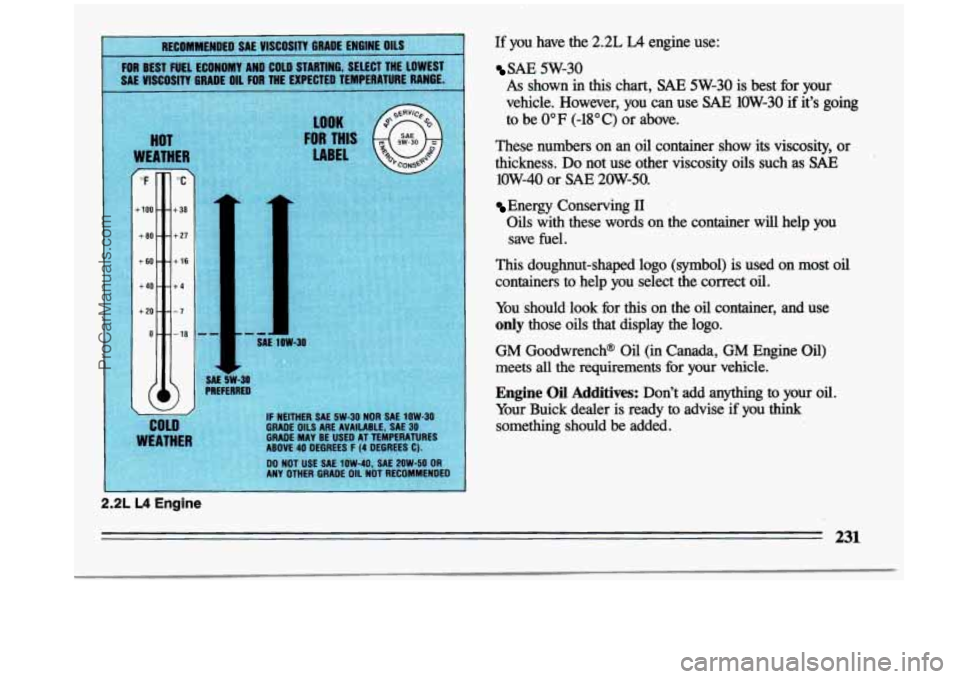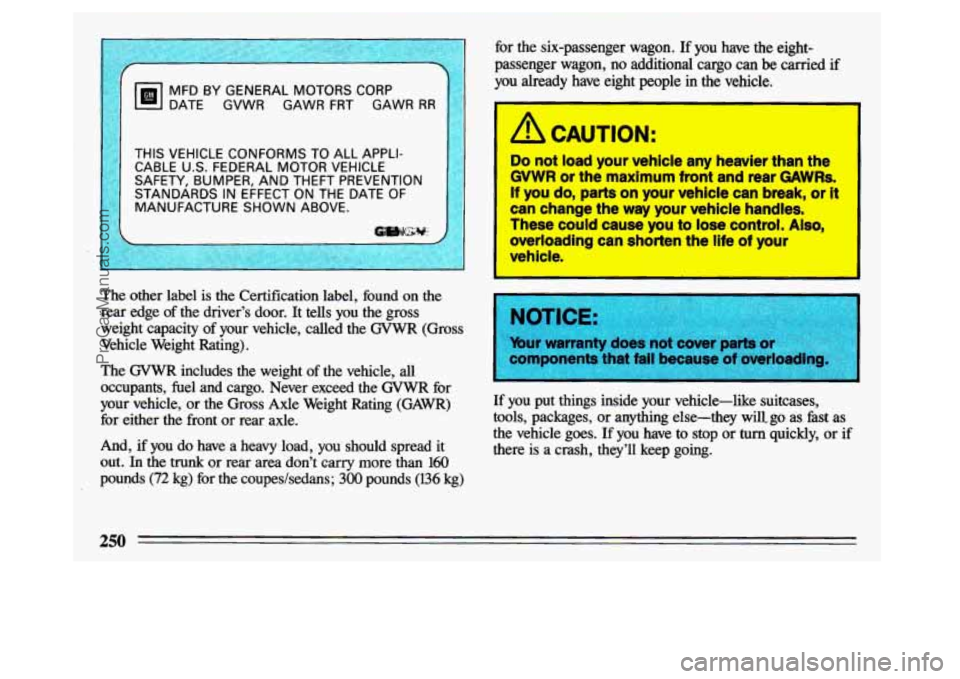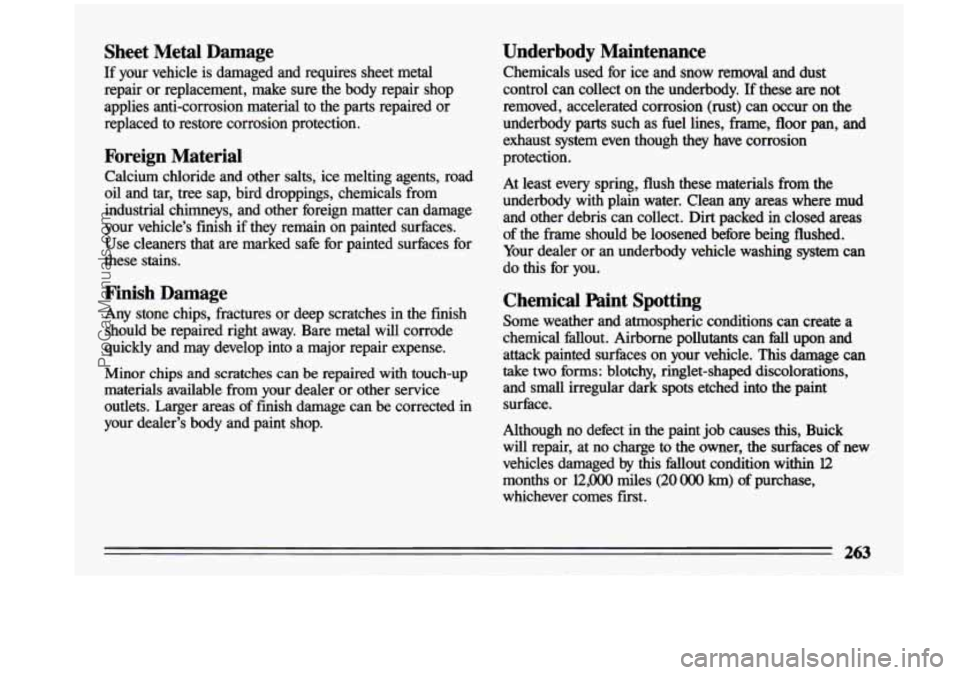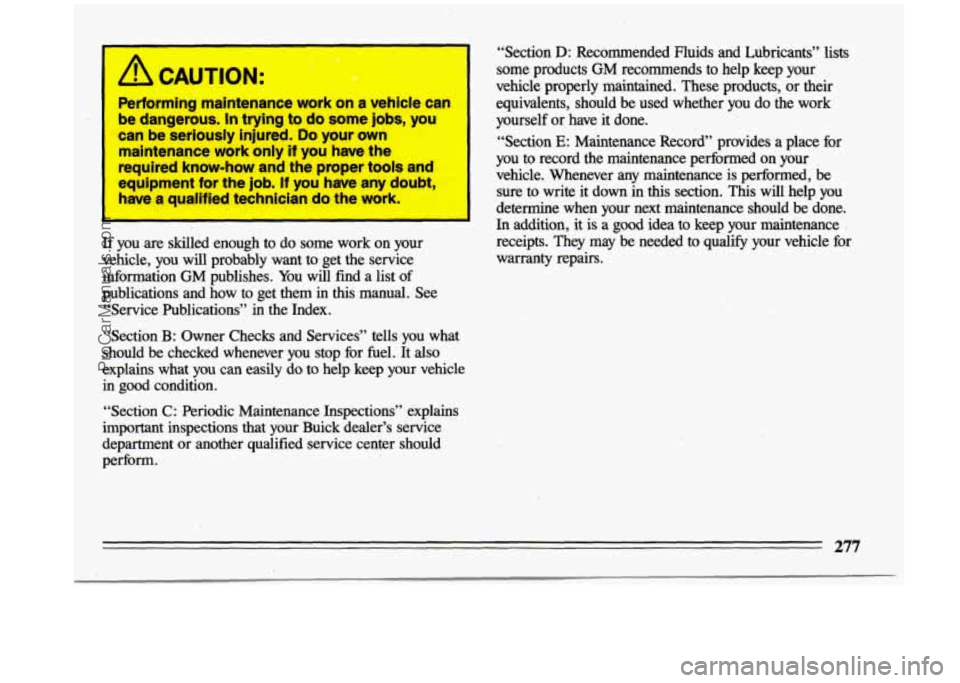1993 BUICK CENTURY fuel
[x] Cancel search: fuelPage 233 of 324

2.2L L4 Engine
LOOK
IR THI
LABEL
SAE 1OW-30
AE 5W-31 REFERREI
IF NEITHER SAE 5W-30 NOR SAE 1OW-30 GRADE OILS ARE AVAILABLE, SAE 30 GRADE MAY BE USE0 AT TEMPERATURES
ABOVE 40 DEGREES F (4 DEGREES C).
00 NOT USE SAE 1OW-40, SAE 2OW-50 Ofl ANY nTHFR CRAllF nll Nil1 RFfnMMFNnl
If you have the 2.2L LA engine use:
SAE 5W-30
As shown in this chart, SAE 5W-30 is best for your
vehicle. However, you can use
SAE 1OW-30 if it’s going
to be
0°F (-18°C) or above.
These numbers on
an oil container show its viscosity, or
thickness.
Do not use other viscosity oils such as SAE
low-40 or SAE 20W-50.
Energy Conserving II
Oils with these words on the container will help you save
fuel.
This doughnut-shaped logo (symbol) is used on most oil
containers to help you select the correct oil.
You should look for this on the oil container, and use
only those oils that display the logo.
GM Goodwrench@ Oil (in Canada, GM Engine Oil)
meets
all the requirements fix your vehicle.
Engine Oil Additives: Don’t add anything to your oil.
Your Buick dealer is ready to advise if you
think
something should be added.
231
ProCarManuals.com
Page 252 of 324

MFD BY GENERAL MOTORS CORP
DATE GVWR GAWR FRT GAWR
RR
THIS VEHICLE CONFORMS TO ALL APPLI- CABLE U.S. FEDERAL MOTOR VEHICLE
SAFETY, BUMPER, AND THEFT PREVENTION
STANDARDS IN EFFECT ON THE DATE OF
I MANUFACTURE SHOWN ABOVE. Qw&$;+#;
The other label is the Certification label, found on the
rear edge
of the driver’s door. It tells you the gross
weight capacity of your vehicle, called the GVWR (Gross
Vehicle Weight Rating).
The GVWR includes the weight of the vehicle, all
occupants, fuel and cargo. Never exceed the GVWR for
your vehicle, or the Gross Axle Weight Rating (GAWR)
for either the front or rear axle.
And, if you do have a heavy load, you should spread it
out.
In the trunk or rear area don’t carry more than 160
pounds (72 kg) for the coupeshedans; 300 pounds (136 kg) for the six-passenger wagon.
If you have the eight-
passenger wagon, no additional cargo
can be carried if
you already have eight people in the vehicle.
A CAUTION:
Do not load your vehicle any heavier than the
GVWR or the maximum front and rear GAWRs.
If you do, parts on your vehicle can brerak, or It
can change the way your vehicle handles.
These could cause you to lose control. Also,
overloading can shorten the life of your
vehicle.
If you put things inside your vehicle-like suitcases,
tools, packages, or anything else-they willgo as hst
as
the vehicle goes. If you have to stop or turn quickly, or if
there is a crash, they’ll keep
going.
250
ProCarManuals.com
Page 265 of 324

Sheet Metal Damage
If your vehicle is damaged and requires sheet metal
repair or replacement, make sure the body repair shop
applies anti-corrosion material to the parts repaired or
replaced to restore corrosion protection.
Foreign Material
Calcium chloride and other salts, ice melting agents, road
oil and tar, tree sap, bird droppings, chemicals from
industrial chimneys, and other foreign matter can damage
your vehicle’s finish if they remain on painted surfaces. Use cleaners that are marked safe for painted surfaces for
these stains.
Finish Damage
Any stone chips, fractures or deep scratches in the finish
should be repaired right away. Bare metal will corrode
quickly and may develop into a major repair expense.
Minor chips and scratches
can be repaired with touch-up
materials available from your dealer or other service
outlets. Larger areas of finish damage can be corrected in
your dealer’s body and paint shop.
Underbody Maintenance
Chemicals used for ice and snow removal and dust
control can collect on the underbody. If these
are not
removed, accelerated corrosion (rust) can occur on the
underbody parts such as fuel lines, frame,
floor pan, and
exhaust system even though they have corrosion
protection.
At least every spring, flush these materials from the
underbody
with plain water. Clean any areas where mud
and other debris can collect. Dirt packed
in closed areas
of the frame should be loosened before being flushed.
Your dealer or an underbody vehicle washing system can
do this for you.
Chemical paint Spotting
Some weather and atmospheric conditions can create a
chemical fdlout. Airborne pollutants can
f$ll upon and
attack painted surfaces on your vehicle. This damage can
take
two forms: blotchy, ringlet-shaped discolorations,
and small irregular dark
spots etched into the paint
surhce.
Although no defect in the paint job causes
this, Buick
will repair, at no charge to the owner, the surfaces
of new
vehicles damaged by this fallout condition within 12
months or 12,OOO miles (20 OOO km) of purchase,
whichever comes first.
ProCarManuals.com
Page 269 of 324

Fuse Usage
I
I
Fuse Rating
(AMPS)
A
B
C
D E
15
20
10
10
15
ECM; MAF Sensor (3300 Engine only)
ECM Injectors/Coil
Eng. A/C Relay; EGR Solenoid; Canister Purge Solenoid
Fan/Elect; Generator; DRL Module
Turn Signal Flasher; Back-up Lights;
TruWLiftgate Release
Fuse
F
G
H
I
J
K
L
M
Rating
(AMPS)
10
20
20
10
20
20
30"
5
Circuitry N
0
P
Q
10
30"
25
20
15
15
15
Circuitry
Supplemental Inflatable Restraint (Air Bagj
Tail; Park; Side Marker; License Plate; Stop/Turn Signal
Heater/Air Conditioner
Gages; Warning Indicators; Torque Convert
Clutch; Audible Warning System; Computer Command Control; Trunk Release; Brake
Warning Indicator; Rear Defog Switch;
Speedometer
Stop Lights; Hazard Flashers
Interior, Underhood, Courtesy, I/P, Trunk Lights; Door
Locks; Horn Relay, Passive Restraint
System, Deck Lid Release, Power Antenna
Liftgate Release; Power Windows
Illumination for: I/P, Radio,
Pod Lights,
Ashtray, Console Light, Heater-A/C Control,
Defog Switch, Headlight Switch
Radio, Cruise Control
Seats, Door
Locks, Rear Defog
Windshield Wipe/Wash
Cigarette Lighter
Safety Belt/Chirne (ICAM) Module (Located
behind the fuse block, above the hush panel.)
Remote Lock Control (Located behind the fuse
block, above the hush panel.) Fuel Pump, ECM (Located under the hood.)
*Circuit Breaker
267
ProCarManuals.com
Page 272 of 324

Capacities and Specifications
Engine Code N1 (LGP2 3300 (3.3L) V6 MFI
Belt Tensions-Automatically controlled by a self-tensioning idler pulley. Tension
Cooling System Capacity
adjustment should never be necessary.
Complete System
................................................. 10.5 Quarts
Radiator and Recovery
Tank Only .................................... 3.4 Quarts
crankcase Capacity
(Less Filter) ..................................... 4 Quarts
Air Conditioning Refrigerant Capacity (Rl2) ........................... 2.38 Pounds
Not all air conditioning refrigerants are the same. If the air\
conditioning system in your vehicle needs refrigerant, be sure the proper refrigera\
nt is used. If
you’re not sure, ask your Buick dealer.
Fuel Tank Capacity
................................................ 16.5 Gallons
8th Character of the Vehicle Identification Number. * Made in a GM plant in the United States.
9.9 Liters
3.2 Liters
3.8 Liters
1.07 Kilograms
62.6 Liters
270
ProCarManuals.com
Page 274 of 324

Capacities and Specifications
Engine Code 4l (LN2)2 2.2L L4 PFI
:Belt Tensions-Automatically . controlled by an idler pulley. Tension adjustment
should never be necessary.
Cooling System Capacity
Complete System.
................................................ 8.3 Quarts
Radiator and Recovery Tank Only
.................................... 3.4 Quarts
Crankcase Capacity
(Less Filter) ..................................... 4 Quarts
Air Conditioning Refrigerant Capacity (Rl2) ........................... 2.38 Pounds
Not all air conditioning refrigerants are the same. If the air\
conditioning system
in your vehicle needs refrigerant, be sure the proper refrigerant is used. If
you’re not sure, ask your Buick dealer.
Fuel Tank Capacity
................................................ 16.5 Gallons
7.9 Liters
3.2 Liters
3.8 Liters
1
.Cn Kilograms
62.6 Liters
8th Character of the Vehicle Identification Number. * Made in a GM plant in the United States.
272
ProCarManuals.com
Page 277 of 324

I
I
Part 7 Maintenance Schedule
IMPORTANT
KEEP ENGINE OIL
AT THE PROPER
'LEVEL AND CHANGE
AS
RECOMMENDED
This part covers the maintenance
required for your Buick. Your vehicle
needs these services to retain
its safety,
dependability and emission control
performance.
Have you purchased the
GM Protection Plan?
The Plan supplements your
new vehicle warranties.
See your Buick dealer
for details.
part 7 includes:
Introduction
A Word About Maintenance ...................... .276
Your Vehicle and the Environment ................. ,276
How This Part is Organized ...................... .276
A.. Scheduled Maintenance Services
Using Your Maintenance Schedules ................ .278
Selecting the Right Schedule ...................... ,279
Schedule1 ..................................... 280
Schedule I1 ................................... .282
Explanation of Scheduled Maintenance Services .... -284
At Each Fuel Fill .............................. .287
B. Owner Checks and Services
At Least Once a Month ......................... .287
At Least Once a Year ........................... .288
C. Periodic Maintenance Inspections ................ .290
D. Recommended Fluids and Lubricants ............ .292
E. Maintenance Record. .......................... .295
ProCarManuals.com
Page 279 of 324

, Performing maintenance work on a vehicle can
be dangerous.
In trying to do some jobs, you
~ can be seriously injured. Do your own
maintenance work only
if you have the
~ required know-how and the proper tools and
~ equipment for the job. If you have any doubt, I
have a qualified technician do the work.
If you.are skilled enough to do some work on your
vehicle, you will probably want to get the service
information GM publishes.
You will find a list of
publications and how
to get them in this manual. See
“Service Publications” in the Index. “Section
D: Recommended Fluids and Lubricants” lists
some products GM recommends to help keep your
vehicle properly maintained. These products, or their
I equivalents, should be used whether you do the work
yourself or have it done.
“Section
E: Maintenance Record” provides a place for
I ‘you to record the maintenance performed on your
vehicle. Whenever any maintenance is performed, be sure to write it down in this section. This will help
YOU
determine when your next maintenance should be done.
In addition, it is a
good idea to keep your maintenance .
receipts. They may be needed to qualify your vehicle for
warranty repairs.
“Section
B: Owner Checks and Services” tells you what
should be checked whenever you stop for fuel. It
also
explains what you can easily do to help keep your vehicle
in good condition.
“Section
C: Periodic Maintenance Inspections” explains
iniportant inspections that your Buick dealer’s service
department or another qualified service center should
perform.
277
ProCarManuals.com